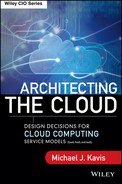PREFACE
If you don’t know where you are going, any road will take you there.
— Lewis Carroll, Alice in Wonderland
In the summer of 2008, after three decades of building software in corporate data centers, I walked away from corporate America to take a stab at building a technology company from the ground up based on a clever concept of the start-up company’s founder. After years of building software within the constraints of existing data centers and the long procurement cycles required to make new computing resources available to build on, I saw leveraging cloud computing as an opportunity to achieve far greater agility at a pay-as-you-go utility pricing model. When I started my journey I tweeted to my social network and asked if anyone knew of any real-life examples of real-time transaction processing occurring in the public cloud. My tweet generated a lot of laughs and snarky comments; after all, who would have thought of processing information from a brick-and-mortar retail point-of-sale system over the Internet with a transaction engine in the public cloud in 2008? One responder laughed and said, “Let me know when you find an example.” It was clear to me that we were pioneers, and we would have to learn things the way pioneers learned: by trial and error. Now, five years later, I want to share my lessons learned with readers so they can rely more on the experiences of others rather than brute force trial and error, like pioneers.
There are many books that define what cloud computing is and how the cloud is the biggest game changer since the rise of the Internet and the birth of the personal computer. The books in the marketplace today typically target management, beginners, or developers. This book is targeting chief technology officers, enterprise architects, product managers, and key technology decision makers.
Several books that target cloud architects get very specific about how to build software in the cloud and often focus on leading vendors. The content within this book is vendor agnostic since all the concepts discussed can be applied to any vendor or proprietary solution. I believe that one of the most critical technology decisions for succeeding with cloud computing is selecting the right cloud service model(s), which should be based on a combination of business, technology, and organizational requirements. Unfortunately, there is a notable absence of information in the marketplace to guide decision makers through this critical decision point. This book is focused on filling that information gap by providing decision makers with the pros and cons of each service model from the viewpoint of a consumer of cloud services.
This book is a must-read for any decision maker starting the vendor selection and development process for their cloud computing initiative. Starting a cloud initiative with a blank sheet of paper is a daunting task. This book provides the reader with an arsenal of design decisions to contemplate and highlights critical areas of concern that all cloud architectures must contend with.
Overview of the Contents
Within each chapter I’ll share a story that is relevant to the topic of discussion. These stories are either a personal experience that I have been involved in during my career or one of a peer or colleague. The names of companies, individuals, and products will be masked by fictitious names. Storytelling helps readers relate better to technical topics because we all have similar experiences throughout our careers. As with any other shift in technology, there is a lot of hype and many myths and misperceptions about cloud computing that lead to resistance or difficulties for some organizations in adopting the cloud. I have observed the same behavior numerous times in my career with the adoption of the Internet, service-oriented architecture (SOA), agile methodologies, and others. I have been fortunate enough to have multiple opportunities to be a pioneer for several of these technology shifts. I will use some stories from the past to show the parallels between the resistance to cloud computing and the resistance to the predecessor technologies.
I have always found that discussing technology in terms of familiar business scenarios helps readers to visualize concepts and makes it easier to translate those visualizations to the reader’s real-life scenarios. I have created a fictitious online auction company called Acme eAuctions (AEA) and will use AEA to describe many relevant business scenarios to help explain key points throughout this book. I will be discussing many facets of AEA’s business, not just its online auction website, so those readers not in the web business need not be alarmed. There will be plenty of scenarios that address relevant business scenarios for all readers.
As You Begin
Architecting the Cloud was written to fill a void that existed when I started building my first cloud application back in 2008. Each chapter provides insights gained through my experiences, both things I got right and things I got wrong. My hope is that by sharing these experiences and providing a list of design considerations in a variety of areas of concern, my readers can make more precise design decisions and will not have to rely as much on trial and error as I did when I first started. Cloud computing can offer tremendous benefits such as increased speed to market, lower total cost of ownership, and greater flexibility if designed correctly, but there are no silver bullets. To achieve these benefits, a pragmatic approach is required. This book aims to arm the reader with a long list of design considerations to help the reader achieve the goals that the cloud promises.
